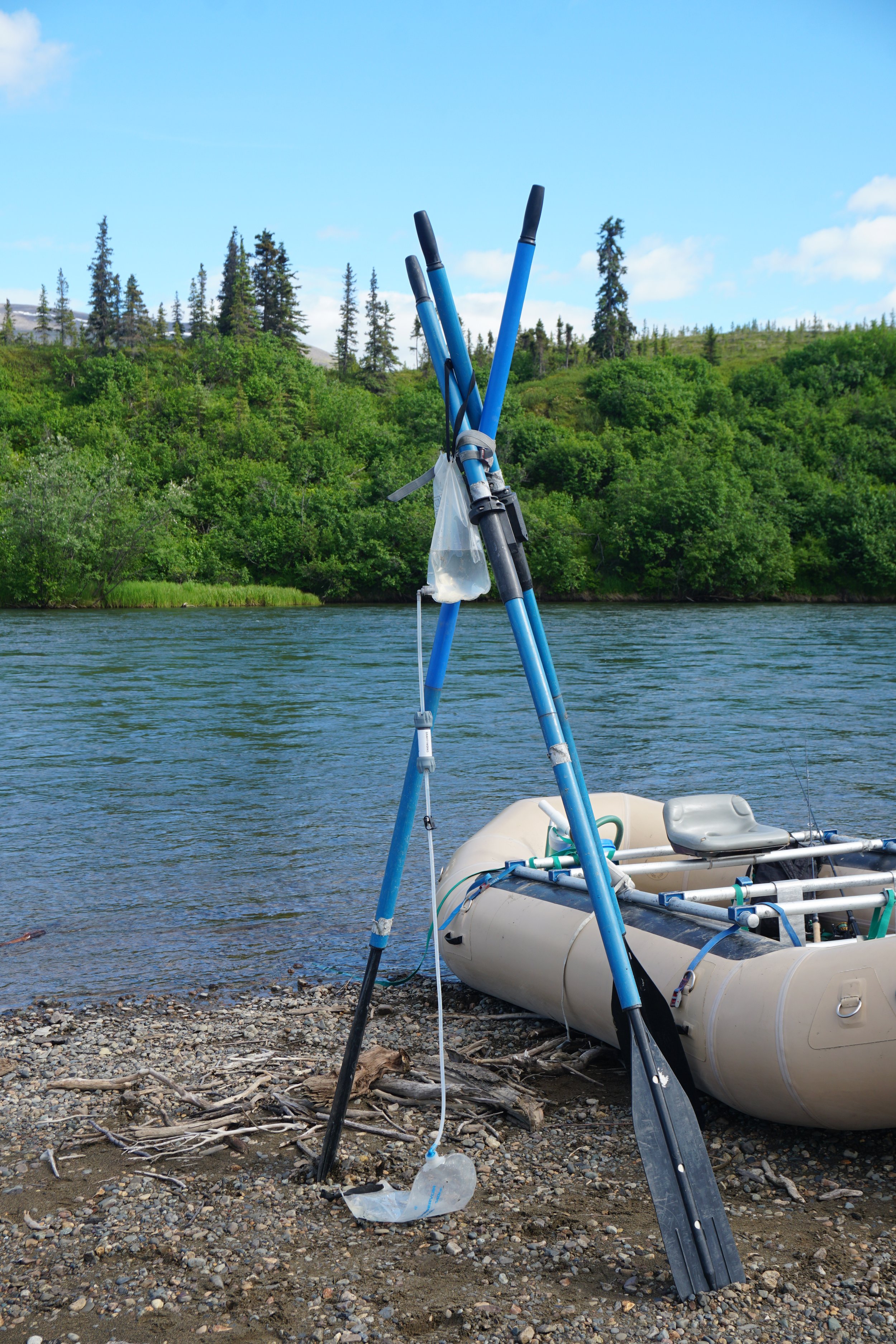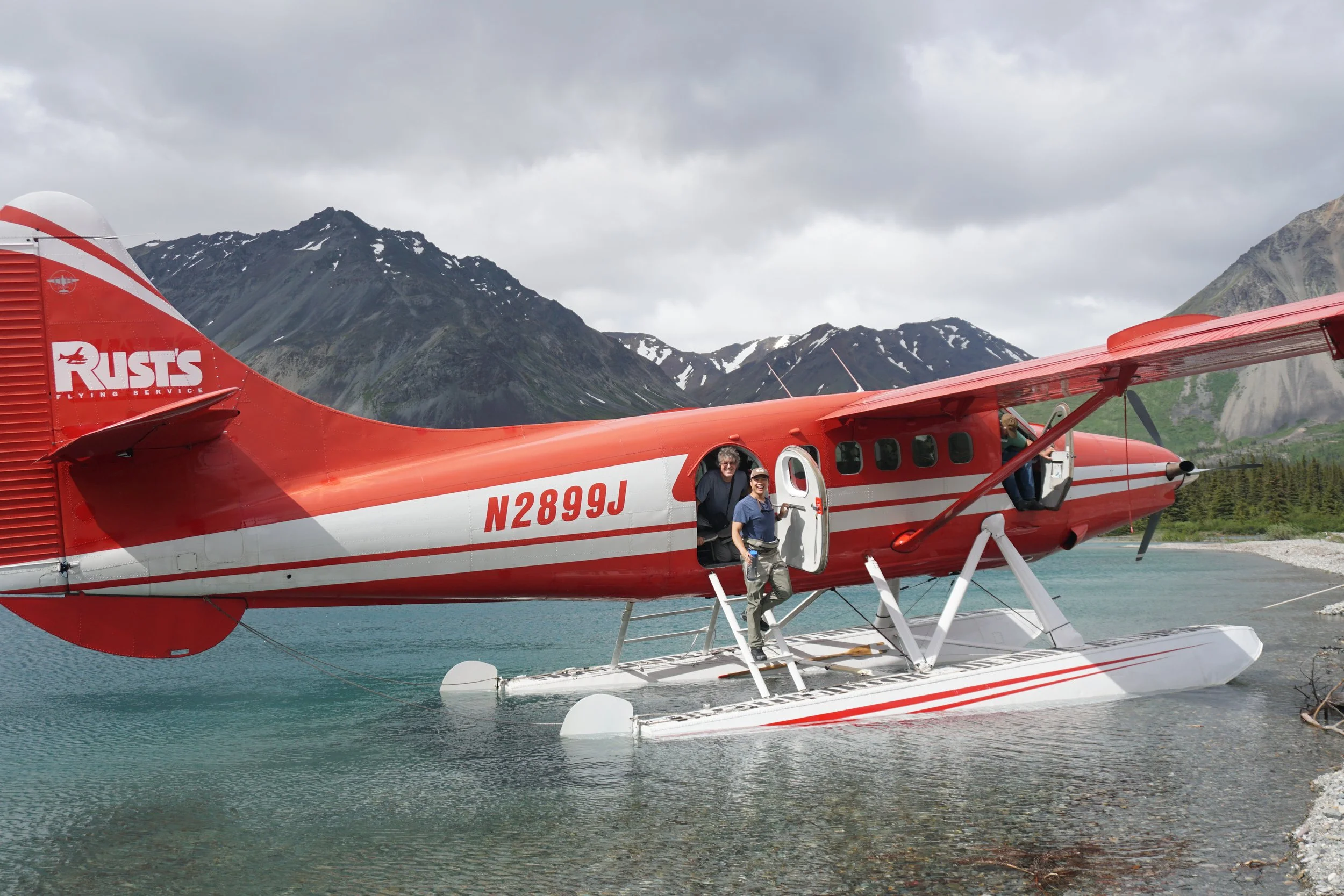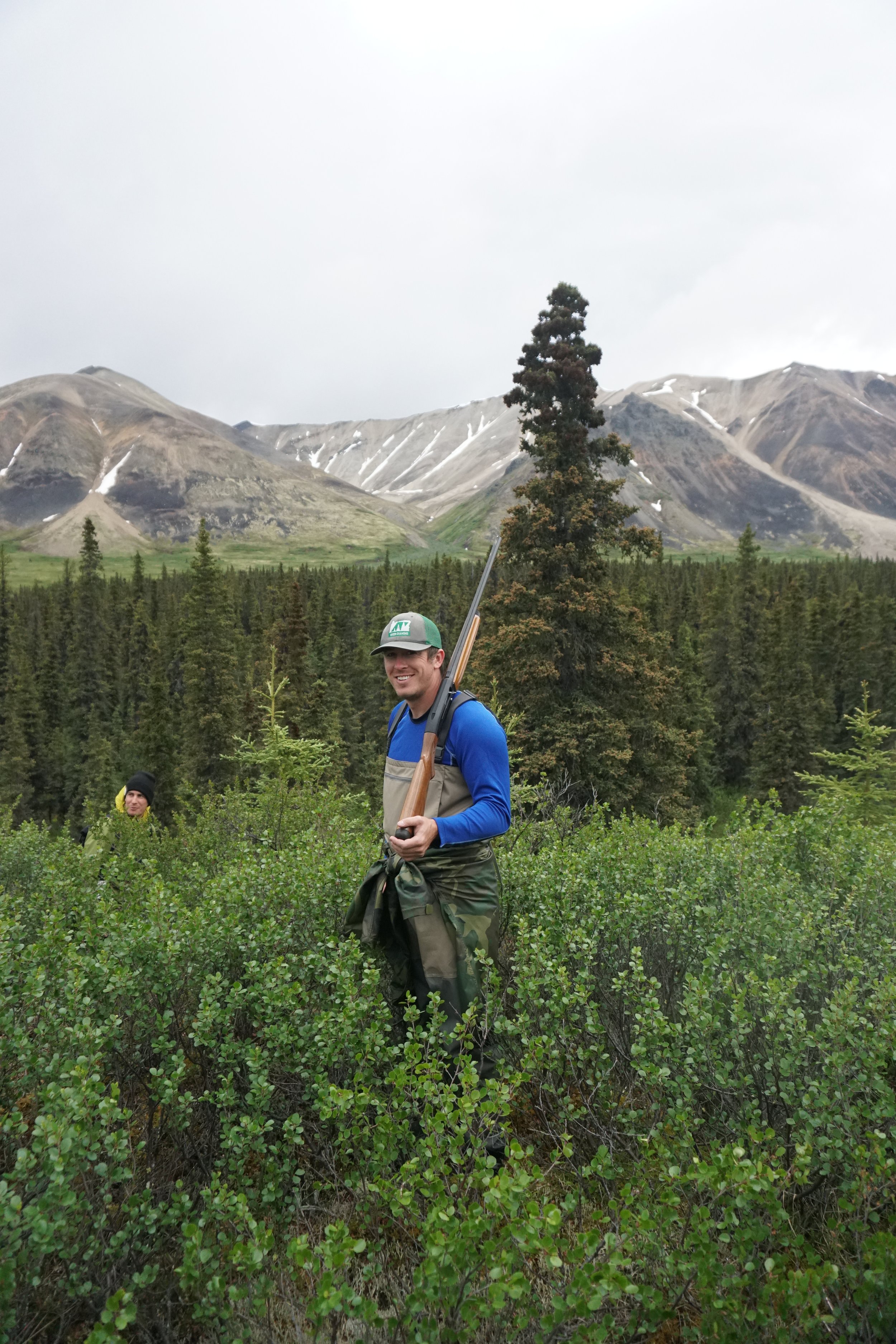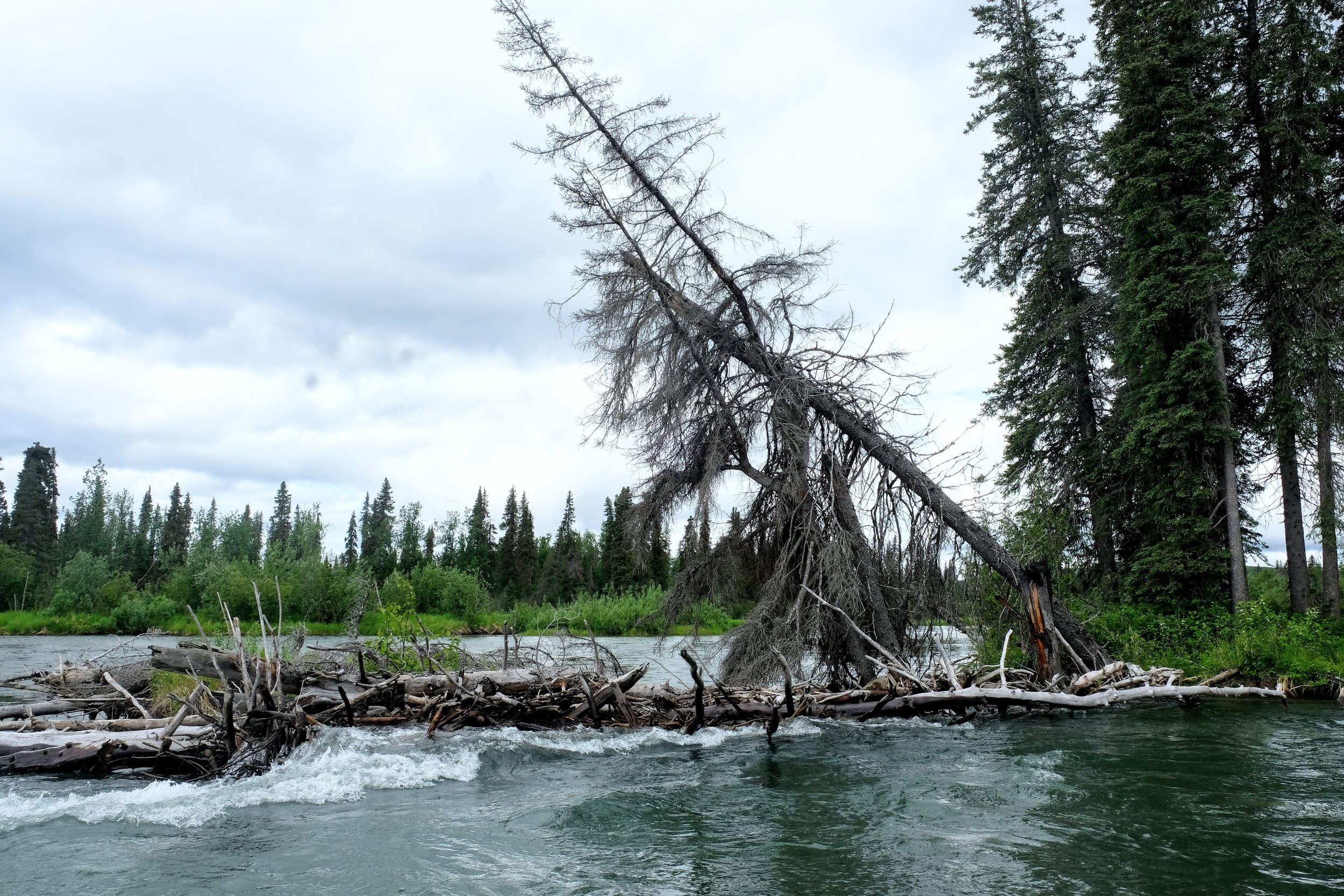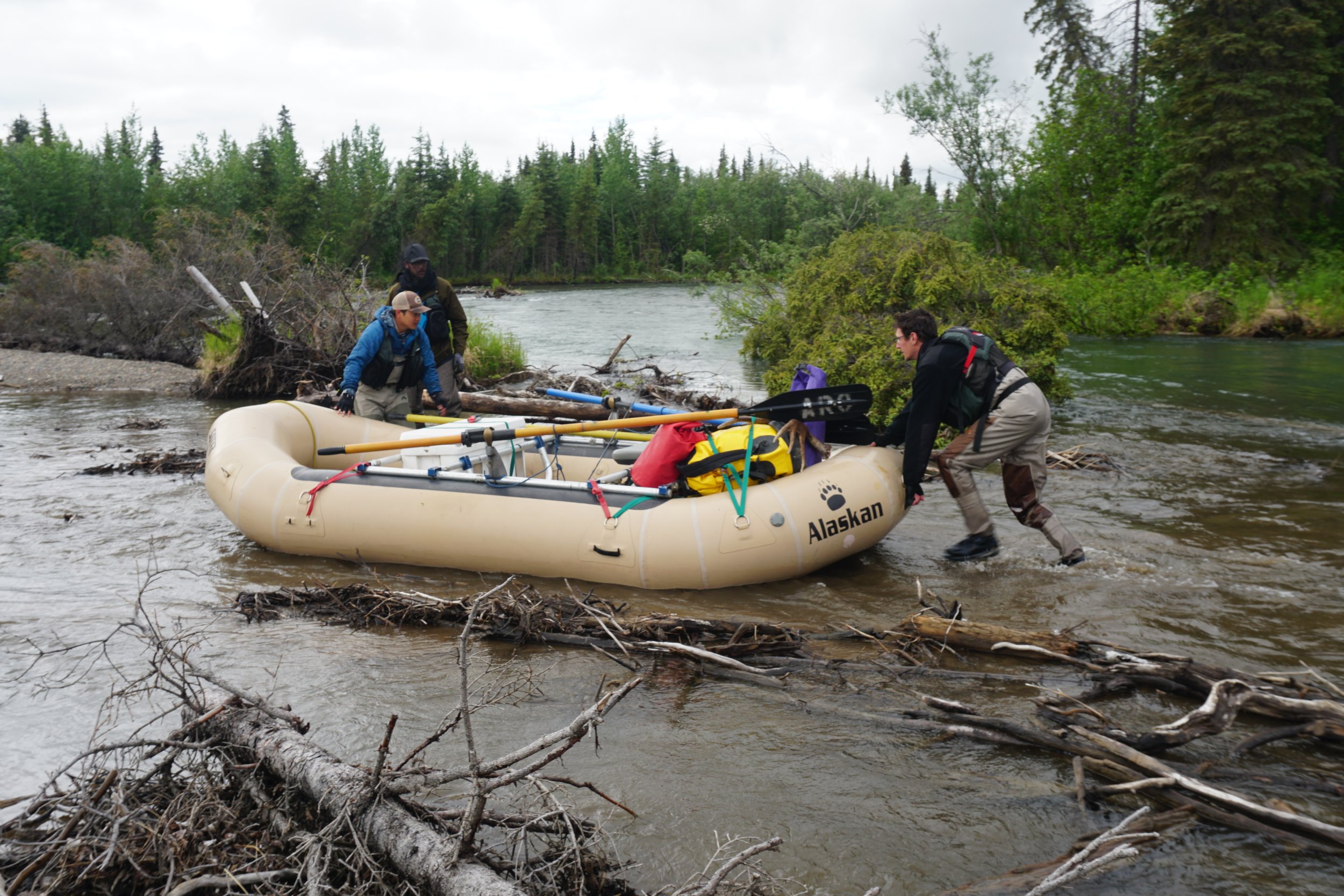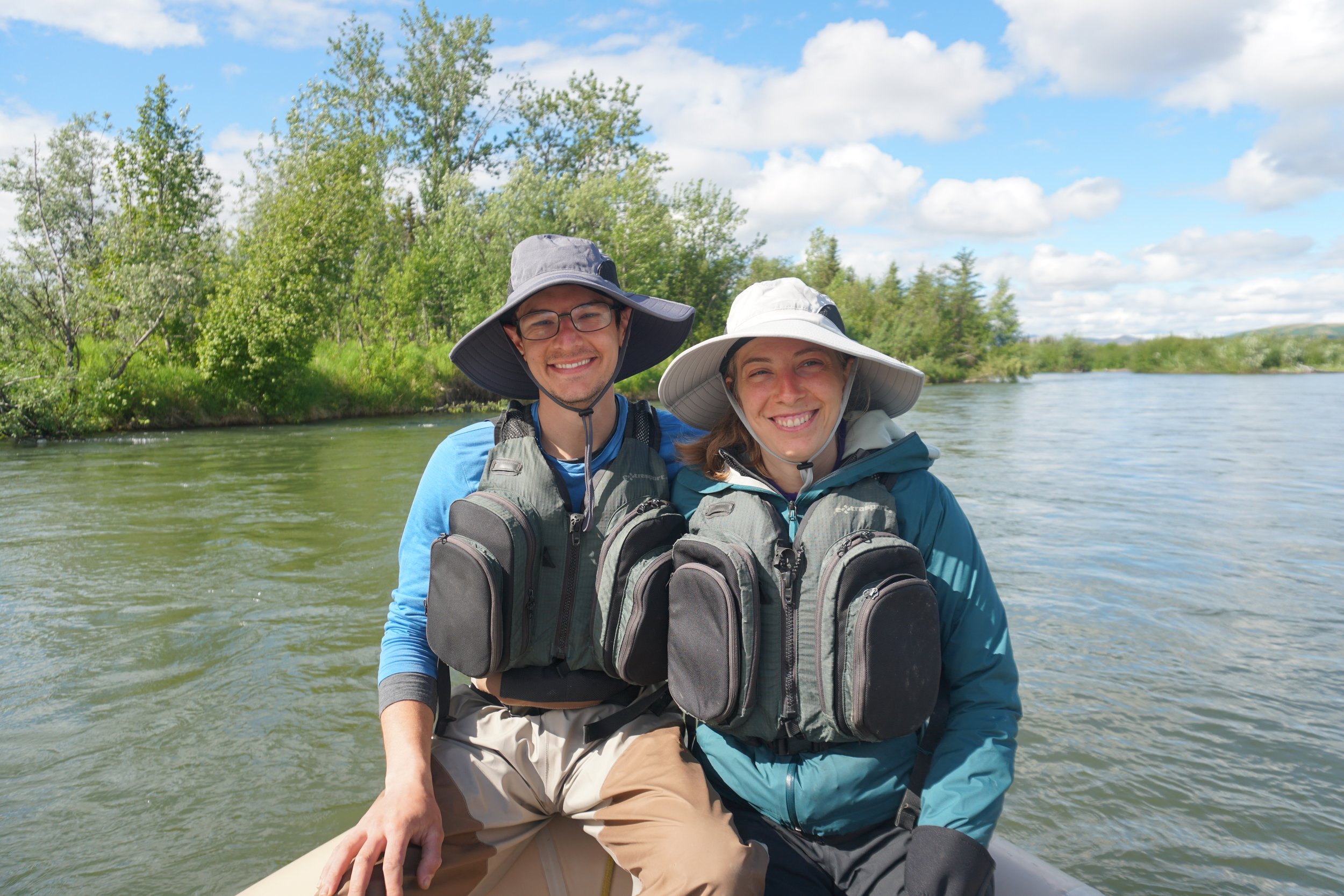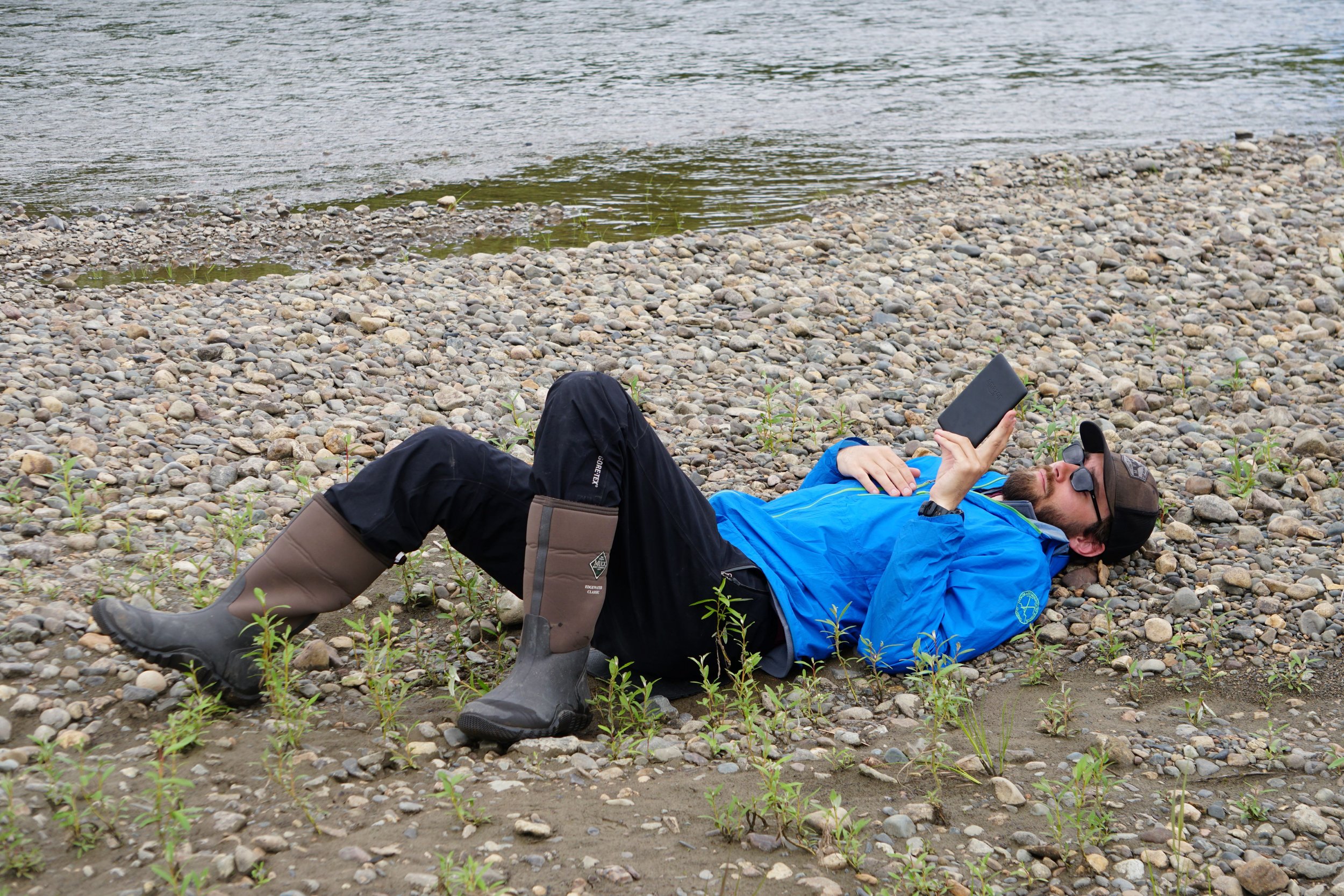Chilikadrotna River Expedition, Alaska
Time for Something Completely Different
After six months of overland travel in West Africa, we were missing family and ready for a break. So we left the truck in Cape Town for some care and maintenance and returned to Bend, Oregon to be with family. And then, because we can never keep things simple, we wedged a remote river float in Alaska into our time at home. Luckily our awesome kids took on the planning so we just needed to get ourselves and our gear together.
The fantastic floaters: Nick, Claire, Trevor, Nathan, Dawn, Alex, Colin, Andy, Nicholas
Our group of nine people included the two of us, our three kids Nicholas, Trevor, and Claire, and their friends Nick, Alex, Nathan and Colin. It was a terrific group - strong in bringing a sense of humor through the hard times and all willing to pitch in at full force when needed. We couldn’t have hoped for a better crew to float with.
Yellow line shows our 85-mile route, which we floated over 8 days, 7 nights
Trip Preparation
The gear list was the most complicated that we have gathered for any excursion to date. We were being dropped by float planes into remote Lake Clark National Park, so not only would we not see any infrastructure or other people for a week, but we also had to abide by strict weight limits imposed by the capacity of the planes. We had to be prepared to be completely self sufficient and ready for angry grizzly bears, grumpy moose, cold rainy weather, persistent mosquitos, and anything else that we could imagine arising in the Alaskan wilderness.
Rafts, oars, and frames ready to go
Our son Nicholas contracted with Rust’s Flying Service out of Anchorage to take us to our launch point at Lower Twin Lake, and with Trail Ridge Air to pick us up eight days later at a pre-selected gravel bar on the Mulchatna River. It took three planes to transport our group and gear each way. He also arranged for gear rental (3 rafts with rowing frames and oars, 3 coolers, stove, life jackets, two roll up tables, and a kitchen box with dishes and pots) from Alaska Raft Connection. Our payload with gear, people, and food was capped at 2,810 lbs. After collecting personal body weights, Nicholas allotted us each 30 lbs of personal gear, including tent, sleeping bag, and sleeping pad. Working with a weight budget of 140 lbs for food for the whole group, our daughter Claire planned meals and created a shopping spreadsheet complete with estimated weights for each ingredient. It was complex!
Gear List
Personal - Clothing
Mosquito head net
Wide brimmed hat
Heavy-duty raincoat (Gore-Tex or equivalent)
Rain pants
Hiking pants (synthetic, permethrin treated)
Hiking shirt (synthetic, permethrin treated)
Heavy insulated jacket
Light insulated jacket (synthetic)
Long underwear top (synthetic– smartwool or capilene or eq)
Long underwear bottom (synthetic– smartwool or capilene or eq)
Warm hat and sun hat
Sunglasses (with retention strap)
Gloves (recommended to get wet and with grip like NRS Hydroskin gloves, or cheaper model)
Waterproof boots (ideally knee-high) or waders
Personal - Camp Gear
Sleeping bag (good for 20 degrees F or colder)
Sleeping pad
Sleeping mask (it won’t be very dark)
Small camp chair (keep it light and small)
Tent - 2-3 person lightweight, can be shared
Water bottle
Personal - Storage
Expedition dry bag - each person to pack personal and camp gear into a Bill’s Bag style bag (provided by Dawn and Andy but also could have been rented)
Dry bags offloaded from the first plane onto the beach where we were putting in. Nathan and Colin feeling the start of the adventure.
Group Gear
Misc
Fishing gear (rods, reels, tackle)
12-gauge with slugs and buckshot
44 magnum pistol with chest harness
Bear spray
Phone-size dry box (if you want your phone/electronics on the boat)
Navigation/Communication
Maps
Garmin inReach
In addition to cell phones with maps of the area downloaded, we carried two dedicated navigation devices - Dawn and Andy’s Garmin inReach which had GPS tracking and an emergency SOS feature, and Alex’s newer model which worked with his phone. Disturbingly, they often did not agree when asked to provide our current GPS coordinates.
And of course, the backup, six USGS topo maps sealed in gallon ziploc bags
Group - Camp
Lighters
Toilet Paper and trowel
Canopy for rain cover
Trash bags
Filet knife
Folding wire grill for cooking fish
Water Filtration system - gravity-fed
Folding saw
hachet
Gravity-fed Platypus water filtration system - invaluable time saver for keeping 9 personal water bottles filled
Group - Kitchen - Part of Rental package
Place settings for everyone (cups + silverware + plates)
Large pot
Medium pot
Large size cast-iron skillet
Spatula
Serving spoon
3-burner propane stove
All-purpose biodegradable soap
Plastic cutting board
Sponge
Roll-a-table (2)
Emergency
First aid kit
Emergency GPS beacon - part of Garmin inReach
Matches - several waterproof cases
We had a little rocky time at the start. The airline to Anchorage lost Nicholas’ and Alex’s luggage, so they had no gear or clothing except for suits for the wedding they were headed off to after the rafting trip. Completely useless. But a quick trip to Sportsman’s Warehouse in Anchorage got them set up with the waders and long johns they ended up wearing the whole trip. Luckily Alex also bought some extra thick wool socks which quickly became our cooking potholders.
Although we did take firearms, we never needed them. We saw grizzly tracks and scat but no bears. We floated by several mother-calf pairs of moose, but none of them acted aggressively toward us. As the first party to float the river in 2023, we were extremely grateful that we brought a folding saw. On several occasions we used it to cut through trees that had fallen across the river, saving us an arduous portage.
Our only true gear failure was the rented three-burner stove, which only worked the first night. Despite repeated attempts to fix it and a side trip on the second day to a ranger station to see if they had parts, it was dead in the water. Luckily, firewood was abundant along the river and we were able to cook over campfires instead.
Rust’s float plane (a Cessena 206) dock at Lake Hood Airport in Anchorage - the busiest seaplane airport in the world
Packing all the food from the early morning Costco run into three coolers - including dry ice in one
And then - after the final weigh-in, we are under weight! Nicholas (our trip renegade) takes care of that by going on a last minute additional alcohol run
Colin, Nathan and Trevor. Three Cal Poly college friends, reunited and celebrating Nathan’s upcoming wedding.
Our daughter Claire and her boyfriend, Nick. Ready for takeoff.
Alex and Andy wedged in the back of a de Havilland Otter behind all the rafts
With everyone on board the three planes, we took off for one of the most scenic flights of our lives. We wound through Lake Clark Pass, soaring past glaciers and bumping our way through stomach-clenching turbulence just under a low cloud layer. Two of the pilots turned back for a longer, calmer route, and one just stuck it out. But we all made it.
Lake Clark Pass from the air
Looking down on the river we would be rafting
Approaching our first night’s camp on the beach at Lower Twin Lake
Arrival at the beach where we launched the rafts
Day One - Camp at Lower Twin Lake
First step - inflate the rafts
Time for a quick dip - note Trevor’s facial expression in the frigid water
Colin (our deep-thinking philosopher) appreciating the sun. A worthy endeavor as it only appeared for very long on the first and last days.
The first fish of the trip are caught
Everyone tucked in for the night - photo at 11pm, it doesn’t get dark in June in Alaska
Packing everything back into the drybags in the morning
Day Two - Crossing the Lake, Hiking, Camping at the River Mouth
Despite the gorgeous scenery, we were trying to travel a daily average of about 15 river miles so we launched the boats with a sense of adventure and anticipation. Knowing that we were in the best hiking area of the trip, we committed to what we thought would be a short day on the water, simply rowing across the lake to the Chilikadrotna River mouth and including a hike along the way.
The short rowing day turned into a long slog across Lower Twin Lake (fortunately aided by constant strong winds), but everyone maintained their cheerfulness. Even the rowers.
Alex and Nicholas (sporting rented one-size-fits-all ponchos), boats loaded, first launch from the beach
A long flat (at first) paddle across the lake to get to the river mouth
Andy in his happy place (when he is not driving a truck across Africa)
Dawn likes to row the slow bits
Taking a break to hike up a nearby peak
Claire and Nick, still so clean! (There were no showers for 8 days)
The hardcore hikers setting off up the peak. Some of us rested in the bush with our Kindles.
The intrepid hikers who made it to the top. Everyone doubting Nick’s sanity hiking a mountain in Chacos. But then, chivalry is not dead. He had given Claire his boots since her brand new boots failed the first day.
We started off worried about bears, but due to a freakishly late spring, the salmon were not present and so neither were the bears. Never fired a gun except for some evening target practice.
Dawn and Andy, the old guard. Trying hard to back off and let the younger generation lead. Sometimes we succeeded.
Long hard row across an increasingly choppy lake (about 4 hours)
Made it across the lake, setting up camp at the river mouth
Overall, finding spots to camp was relatively easy. But we were really glad we stopped at this particular location at the mouth of the river as the next morning we noticed there were not any places for the next few hours. But for the rest of the trip, it seemed that there were suitable places about every 30-45 minutes.
We looked for relatively flat, small gravel, places for 6 tents and firewood. We also prioritized greenery that provided private spaces for private business and visibility so that nothing scary could sneak up on us. We quickly realized that the best gravel bars were usually on large islands in the river. This gave us a false sense of security for bears and moose- it was evident that they used the islands but somehow we felt safer being surrounded by water.
Grizzly paw print on one of our river island camp sites
Our spot at the river mouth had a great fishing hole! Nathan, our trip wildlife biologist and talented photographer, here with his first fish, an Arctic grayling.
Day Three - Entering the Chilikadrotna River
We needed to make up some miles from our short distance float and hike the previous day and the river cooperated. Splashy and fast, the river moved us along at top speeds of 5-6 miles per hour with a strong downriver wind. The Class I-II water was easy to navigate.
Claire and Nick, ready to launch
Sweepers (overhead trees and bushes) and strainers (underwater logs and brambles) were ever-present but nothing we couldn’t navigate.
We couldn’t find a gravel bar for lunch so everyone just laid down in the soft muskeg, ate and took a nap.
Alaska is a land of natural contrasts and this was evident in the trip. With so many photographers and naturalists on board, we took the time to appreciate the intricate natural beauties alongside the vast mountainous expanses.
Photo credit: Claire Elsbree
Photo Credit: Alex Huang
Photo credit: Nathan Tallman
Trevor capturing the scenery
Beer time! We were, after all, on vacation.
It was a great day zipping along the upper stretch of the river, good spirits abounded and the scenery was spectacular. We were slowly pulling away from our mountain views but we still felt their majestic presence.
Claire, also known as the trip comptroller and chef. She made sure we all had equal numbers of Snickers bars (daily rations of one each) and took the lead on every meal. Pictured here, an enormous pan of bean dip with cheese and salsa, ready for the fire.
Day Four - Moving Along the River, More Fish
Checking the maps over breakfast. We are all wearing our heaviest layers. Temperatures averaged in the 50’s during the days but persistent clouds, wind, and occasional rain made it feel colder.
Alex with his first fish, a rainbow trout. By far our most cheerful trip member, our eternal optimist and voted most photogenic by the group.
Trevor, iconic rolling stone - always planning the next adventure and the instigator of the annual Alaska water trip.
The fishing was a minor disappointment for us. In planning the trip we were trying to balance weather, mosquitos and fishing season. We hit the right balance with reasonable weather and a lack of mosquitos. But we missed on the salmon run. Due to a late season, the salmon were not running. So the fish we caught were more scarce than we expected and hard fought for.
An all too common scenario, rescuing the lure. Many were lost.
Breaking out the kitchen rain canopy for the first time. Learning the intricacies of cooking over an open fire.
Morning at camp
Day Five - More Splashy Water, First Mosquitos and First Moose
Nicholas making good use of those last minute waders
Claire and Dawn not so much into fishing (although happy to eat the catch), hanging in the soft boat with Kindles ready
Nick, avid Alaska outdoorsman, gives Alex a run for his money for most cheerful, especially when fishing.
Bachelor boat, living it up
First mosquitos, head net, no problem, activities continued as usual.
Cow and calf in the water! Photo credit: Nathan Tallman
First evening chore, collecting firewood.
Evening comes at camp
Day Six - Sweepers and River Debris
The river was still splashy but slowing down somewhat. The big snowy peaks had disappeared and were replaced with forests and green rounded hills. We had not encountered any technical rapids or difficulties despite there being rumors of some Class III. The water felt high so we assumed they were washed out.
But as we headed downriver, there were more instances of the river splitting into multiple channels and last minute judgment calls required to choose the way. There was also more debris blocking some routes. Sweepers and log jams were common.
The channel we did not take
Typical log jam
Then we hit our first major road block. A cottonwood had fallen across the main channel. Nicholas’s boat was swept right into it, and the force of the river pressing the raft against the tree almost flipped it (the “high side” alert definitely worked as 450 lbs of human beings jumped on the high side to right the boat). We pulled over and began the rescue, which culminated in Nicholas cutting away the tree with a saw so we could all pass by.
Success - brotherly high five.
But the river challenges were not over for the day. Next obstacle: a larger spruce blocking the main channel with logs and debris blocking a secondary, shallow channel. Inspection of the spruce led to the conclusion that our saw was not up to the task so we cleared the debris in the secondary channel and dragged the boats through the shallow water.
Downed spruce blocking the main channel
Pulling over to evaluate
Clearing the debris
Dragging the boats through
Back on the float again
Successful teamwork! There is a beautiful sense of camaraderie that comes with knowing you are the only people for 100’s of miles and are relying on each other to overcome an obstacle.
Time for river lunch
Cleaning up the last of the food, Alex opted for a peanut butter and trail mix burrito
Beautiful eagle sightings on the river - photo credit Nathan Tallman
How cute are those matching hats . . .
Semi-Palmated Plover chick - Photo Credit: Nathan Tallman
Rain tarp up, and the sun comes out as another successful day ends
Night fall (sort of) on camp
Day Seven
Our last full day on the river! Some of us are feeling melancholy, some are looking forward to that hot shower. But activities continued, never a dull moment on the river.
Time old river tradtion, rock skipping
Nathan, the ever cheerful biologist, just enjoying life
Neck rubs anyone?
More fishing!
Sometimes the introverts just needed a quiet moment. We still took photos of them though.
Who needs a sleeping pad and a pillow?
More group bachelor smiles, friends for life
Semi-Palmated Plover adult - Photo Credit: Nathan Tallman
Back on the river, last full day!
Some last sweepers tried to get us
Tracking our GPS location carefully, we opted to camp about a mile before our pick up spot. We were not sure what the camping would be like at the take out. (We were told “sometimes there is a gravel bar.”)
Last camp on the river
Day Eight - Take Out and return to Anchorage
A quick 20 minute mile on the river and we arrived at the point that all of our devices agreed was the right place to meet our planes at 2pm. Turns out it was a reasonably large gravel island. We deflated rafts, re-packed all our stuff, used up the rest of our ammo with a shooting competition, and breathed big collective sighs of relief when we saw the planes overhead.
The best way to deflate a raft
The targets . . . Yes, we used a Target bag
The game (Nicholas won)
The plane, the plane
Time to load up
Last bucket brigade of gear loading a de Havilland Beaver
And off we go, looking back along the Chilikadrotna. It treated us well.
Views from the plane on the way out
And back to Lake Hood
It was one of those adventures of a lifetime that we will hold in our hearts. The combination of the stunning scenery, the remoteness, the wildlife and the company was unmatched. We are grateful to our travel companions for literally taking some of the weight from our 60-something-year-old bodies, and for the joyful spirit everyone brought. This blog is different from our overland journey ones but we hope this writeup may be helpful to any others contemplating a similar trip. Happy to answer any follow up questions and thank you for reading!







